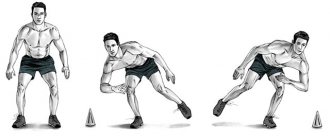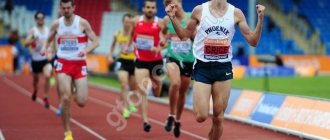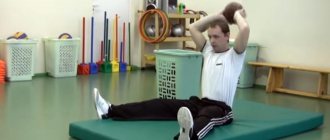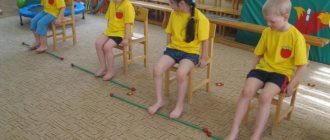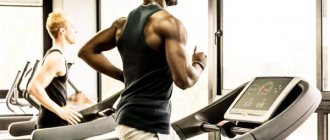Running is one of the most popular types among all sports disciplines. Running is practiced not only by amateurs who want to get in shape and stay healthy, but also by professionals. Running disciplines are a component of athletics and belong to the Olympic sport. There are differences in running between amateur and professional sports. For those who want to benefit from such a discipline, recommendations are provided on the technique and frequency of independent training.
The benefits of running for men and women
Running can provide many benefits for your health and overall functioning. Only if you have the correct running technique, breathing, and moderate heart rate can you benefit from training, otherwise you can do just as much harm.
- Running strengthens the cardio-respiratory system - the heart, blood vessels, improves respiratory function and improves blood circulation.
- Tones all muscles, organs and systems of the body.
- Improves the function of the musculoskeletal system - strengthens bone tissue.
- Improves blood circulation in the pelvic organs - helps improve sexual function.
- Saturates all cells with oxygen, improves overall physical and emotional well-being, prevents stress, and improves immune function.
The effect of running on the body as a whole
Running is the simplest and most effective physical exercise that allows you to use almost all parts of the ligamentous and muscular system. In addition, the joints of the human body also receive a useful load while running. Running increases blood circulation, saturates all organs and tissues with oxygen. It trains the vascular system and prevents many heart diseases.
Jogging helps cleanse the body of harmful toxins and waste. During exercise, blood begins to move through the vessels with high intensity. Through the walls of blood vessels, many waste substances enter it, which are eliminated through sweat. With slow, long running, the body's metabolic processes are normalized, and the cholesterol level in the blood decreases.
Jogging helps you get rid of extra calories. No wonder running is considered one of the most effective ways to lose weight and is included in most weight loss programs.
According to scientific research, running promotes the production of endorphins - hormones that make a person feel joy, happiness and optimism. In addition, running increases a person's endurance, making him more efficient.
Regular running training improves the body's recovery functions. This effect will be especially useful for people who often work night shifts. As a result, a short run turns out to be more effective in invigorating than a relaxing rest or even sleep.
Studies have shown that almost 70% of men who started running regularly have improved reproductive system activity. In other words, running can also enhance male potency.
It is an established fact that jogging has a positive effect on the nervous system. A person for whom running has become a daily norm of life becomes less hot-tempered and more balanced, he controls his emotions more effectively and tolerates stressful situations more easily. For many people, running helps reduce depression or get rid of it completely.
It has been proven that jogging has a positive effect on a person’s mental abilities, as it increases the level of concentration, self-control and brain activity. Running can also provide invaluable help with various sleep disorders, as it has a calming effect on a person’s emotional and psychological state.
What muscles work when running
The main load when running falls on the lower leg muscles (soleus, gastrocnemius), thigh muscles - quadriceps and biceps, as well as the gluteal muscles. But you cannot judge running only by the movement of your legs; other muscles also receive sufficient load.
Due to the simultaneous movement of the arms while running, the torso muscles, abdominal muscles, back muscles and arms are also constantly under tension. Therefore, running affects even the smallest muscles of the body, strengthens not only the legs, but also tones the whole body.
- Choose suitable clothes and shoes
Properly selected shoes are of great importance for a runner. It should be comfortable and match the running style of its owner. Under no circumstances should you
putting on a new pair of sneakers - your feet can wear out until they bleed even in your usual shoes, but in a new pair, according to the experience of most marathon runners, this will happen for sure and, most likely, already in the first kilometers of the distance.
As for clothing, if possible, you need to choose things with a minimum of seams - during a long run they can chafe, and the pain caused by this will complicate the already difficult task of reaching the finish line.
Running technique
- When running, it is important to keep the axis of the spine in a natural position - you should not pull the pelvis back, performing a strong tilt, or push the pelvis forward, tilting the torso back. Both positions will slow down your speed and have a negative impact on your joints and spine.
- The foot must touch the entire surface of the ground or path. Land on the center of your foot, not your heel or toe.
- Move your arms at the same time as you move your legs , your arms help you accelerate better and make your torso muscles work.
- Don't hold your breath or breathe too quickly. Inhale through your nose and exhale through your mouth, releasing the air slowly.
- Try to inhale when your right foot touches the floor , this will avoid internal pressure on the organs and eliminate pain in the side.
- The feet should be in a parallel position to each other , without moving inward or apart.
Most popular questions
We are sure that you have definitely asked yourself at least a couple of questions from our list. It's time to find out all the answers!
Is it necessary to buy running shoes?
In general, the right shoes are an integral part of comfortable running. And we are talking about convenience here: good sneakers help to properly distribute the load on the spine and knee joints, as well as facilitate the process of exercising. Good shoes should be as light and “flexible” as possible (in the sense of not pinching the leg and allowing the foot to flex and extend when running). Special sneakers, as a rule, have these parameters. In them you will be as comfortable as possible while jogging, and the risk of overloading your joints will be minimized. That is, the answer to this question is this: it is still recommended to buy running sneakers.
It must be remembered that such shoes wear out quite quickly. It needs to be changed every time you run a total of 500-600 kilometers in them.
And don’t be confused by the fact that the sneakers look quite normal: their properties that ensure your safety have already come to naught.
Is it true that runners often suffer from knee problems?
Unfortunately it's true. But the reason here is not in running as such, but in the fact that runners (especially beginners) do not follow the correct technique. Or they exercise in inappropriate shoes. Or they ignore injuries without waiting for a full recovery. But the most common problem is overload. For some reason, everyone wants to immediately run ten kilometers, forgetting that such a result is achieved gradually, and you need to start small. In general, don’t try to conquer the marathon distance right away. Go towards your goal a little at a time. More precisely, run. And your knees will be healthy.
Is a warm-up/cool-down necessary?
Yes, we need it . There is generally no research showing that warming up or cooling down helps reduce the risk of injury. But they are definitely beneficial for muscles and ligaments. It is best to do stretching: first, it will help prepare the body for running, and the workout will seem a little easier, and after a run it will reduce the feeling of fatigue and tension.
You can find exercises for cool-down and warm-up in this video:
What distance should a beginner start with?
There is no specific data on this issue. It is recommended to monitor your sensations: if you feel pain in your legs or chest, it’s too hard for you to breathe, and your heart rate is incredibly high, you should slow down the pace or even stop training. Don't try to run as fast as possible: the speed should be comfortable for you! If you find it difficult, alternate between running and walking.
As for the distance, try starting with a kilometer. Increase the load once a week. If you alternate between walking and running, reduce your walking time. You can also increase the distance, but no more than 10% per week - this is the method of increasing the load that is considered the safest.
Where is the best place to study?
It’s difficult to answer unequivocally: it all depends on what your initial goal is. If you just need running to keep your muscles toned , then a treadmill will do. This is the safest type of such training, allowing the best to reduce stress on the joints. If you want to lose weight , then run in the park. Natural unevenness of the ground, as well as natural obstacles, make the workout much more difficult, but you will burn a lot more calories! So it's worth it. What you definitely need to avoid is running on streets that are constantly crossed by traffic. You'll just stop all the time and won't be able to maintain the desired pace. And you will only waste your time: there will be little benefit from such training.
What is the best time to go for a run?
Each organism is individual. Some people prefer morning workouts, others prefer evening workouts. In general, it is believed that it is better to perform long workouts at a low pace in the morning.
If you have a free hour in the morning, you can completely spend it on a measured, easy run. This will help you cheer up and give you strength.
In the evening, on the contrary, it is better to do high-intensity workouts to increase strength and strengthen muscles. So your evening run should be short but intense. It's up to you to decide what's best for your body.
What to eat before and after training?
Runners need protein and carbohydrates. The first are for strengthening muscles, the second are as a source of energy. In general, it is recommended to run no earlier than two hours after eating , but if your jogging is in the morning, still shouldn’t train on an empty stomach: you simply may not have enough energy. To get it, eat some healthy carbohydrates in the form of a banana or a slice of whole grain bread 20 minutes before training And be sure to drink water. It doesn’t matter what time of day you run – water is always essential for a runner, including during training. Drink some water every quarter of an hour while you exercise. In general, as you understand, a bottle of clean liquid is your faithful friend who must accompany you on every run. Do not forget about it.
Is this dangerous for the heart and blood vessels?
According to the latest medical research, running is not only not dangerous for the cardiovascular system, but, on the contrary, reduces the risk of heart attack. However, this is only true for a healthy person. People with heart and vascular diseases , as well as obesity and metabolic disorders, are at risk and may even die from cardiac arrest while jogging.
If you have any doubts about your health, be sure to consult your doctor before starting to run. Only he will tell you whether you are ready for this.
varicose veins can also be a signal that you need medical advice . In general, remember that it is very important not to overload your body, follow the technique and, if you have any health problems, follow the instructions of your doctors. Take care of yourself!
Technique and basic rules
We have mentioned more than once above that only technically correct running will give you maximum benefit and be safe. So what is this correct running like? Read below.
- When running, watch the position of your feet: the correct movement of the foot is from heel to toe.
- Do not turn your socks in opposite directions! On the contrary, try to direct them a little inward: this will reduce the load and increase the speed.
- Don't raise your knees too high. This is quite energy-consuming and, moreover, can be unsafe.
- Relax your shoulders, bend your elbows, clench into a fist. Try not to overexert your arms: let them move freely next to the ribs. Don't make too intense movements. Let your arms move at the same pace as your legs.
- Lean your body forward slightly. The key word here is “slightly”. Leaning too far will result in loss of balance and excessive stress on the spine. It’s also better not to turn from side to side: keep your back straight.
- Keep your head up! Look straight ahead, otherwise you will cause neck pain.
- Watch your breath! Try to breathe deeply and in the same rhythm. Focus on the steps: inhale - three steps, exhale - also three steps. Inhale through your nose, exhale through your mouth. And don't hold your breath! It will throw you off your rhythm.
You can learn more about the correct running technique from the video:
That's all! As you can see, proper running is not that difficult. But it is very useful. Of course, if you follow all the recommendations. By the way, you don’t have to run every day: three workouts a week is enough to notice improvements. Start now, and in a month you will see the result! And all we can do is wish you success.
Types of running
It is important to understand that professional and recreational sports have their own differences, requirements and goals. Professionals must show maximum results in a short time. Health running has its own goals and methods.
In athletics, there are the following running disciplines.
- Sprinting – designed to cover 30 m, 50 m, 60 m, 100, 200, 300 and 400 m in a short period of time.
- Middle distance running – covering 800, 1000, 1500, 2000 and 3000 m.
- Long-distance running is overcoming more than 3000 m, or daily running, in which you need to run the maximum possible distance in a day.
- Marathon and half marathon – in the classic marathon the distance covered is 42.195 m, the half marathon is 21 km.
- Steeplechase - designed to overcome obstacles in a circle of a stadium or arena for 2000 - 3000 m.
- Hurdling – performed at distances: 50 m, 60 m, 100-110 m, 300 and 400 m, with light hurdles installed.
- Relay running - passing the baton from one athlete to another, performed 4x100 m, 4x400 m.
In fitness , even school programs, and recently in CrossFit, the following running standards are often used.
- Shuttle running - there are different distances, at which the standard must be fulfilled in the shortest possible time. This type of running develops speed, endurance, and agility, so it is often used in popular fitness areas.
- Interval running – performed with alternating acceleration and rest (walking), suitable for training aimed at losing weight and increasing endurance.
- Jogging or jogging is a moderate run at a speed of 7-9 km per hour. The style is designed for health training, suitable for people of different ages and physical fitness.
- sprint running is a type of athletics running over short distances, but is often also used in fitness for interval training, for example, alternating strength exercises with maximum acceleration over short distances (up to 400 m).
— Assess your physical fitness
Running a marathon sounds nice, with a hint of heroism. Without which, let’s face it, the participants of such a competition cannot do without it – it’s just not possible to run 42 kilometers. It is believed that a half marathon requires active training for 2-3 months, and a marathon - for at least 4. This is a big load for the body, so both the volume of training and the distances you cover must be increased gradually.
But don't get too carried away
, especially if there are a couple of weeks left before the competition.
During this period, on the contrary, you need to reduce the intensity of your training, otherwise by the day of the race your body will be exhausted. While training, monitor your well-being
- malaise and pain cannot be left unattended, as in the future they can “grow” into injury.
Ideally, overcoming long distances like half marathons and marathons should be a logical continuation of a long passion for running and regular training. This is what can give a runner proper physical preparation.
“People who decide to increase their endurance need to adhere to a certain regime - in particular, regularly train,” says Elena Govorova, Herbalife fitness expert, Olympic bronze medalist in the triple jump. — It is important to recover after classes.
The isotonic protein-carbohydrate drink “Increasing Endurance” HERBALIFE24 copes best with this task. This drink provides energy to effectively continue your workout, provides protein and restores water-salt balance. And also eat a balanced diet - the result of your work in training largely depends on what kind of diet you have.”
What is the best time to run?
There is no specific best time for everyone, the timing of training varies from person to person. The body must awaken; for most people, training in the morning causes great difficulties, since the body has not yet recovered from sleep. It is considered to be the most effective training in the daytime and evening, especially aimed at interval, sprint, and shuttle running. Jogging is suitable as a health-improving workout in the morning to boost your energy levels and improve your health.
- Run at a comfortable pace
The optimal running rhythm for a particular athlete is developed during training. A comfortable, familiar pace must be maintained during the competition. Even if you strive to show a good time result, do not try to “squeeze” maximum speed out of yourself. This is especially important in the first kilometers after the start. They are usually the easiest for runners.
Full of strength, they strive to speed up, but there is no need to do this, because this surge of strength after some time will be replaced by their decline - at the end of the distance it will be almost impossible to maintain the speed set at the beginning. Save your energy and run so as not to experience any discomfort, and also, don’t think about time.
“If you think about time, you will lose your running pace. Today it’s important to run and enjoy running,” says Elena.
How long should you run?
Any running workout for developing endurance, losing weight or getting healthy should not last more than an hour. This is fraught with excessive stress on the heart, which contradicts the health-improving properties of running. Depending on the goals , the duration of the training is selected individually. To lose weight and strengthen the body, 40-60 minutes of aerobic exercise is enough. To improve general condition, maintain shape and health, people of any age (without contraindications) can exercise for 30-40 minutes.
You shouldn't train every day; alternate a running day with a rest day. You can also train 4 times a week, but you must leave 3 days of rest for recovery.
— Spend the day before a long race correctly
The day before the competition should help you and your body get ready for the challenge ahead.
First
, what you will need is rest. If the race is preceded by an exhausting working day, nothing good will come of it.
Second
is energy, and it is better for the body to extract it from “complex” carbohydrates.
Third
- this is a dream. Don't allow yourself to go to a race without enough sleep. Healthy sleep will give the body the strength it needs for a long run. Also, in general, try to avoid any stress and tension because the rigors of a long run are not easy to cope with without inner peace and self-confidence.
As for the morning before the race, it should also be spent with benefit for the body. “For example, it is important to wake up 3 hours before the start - this will allow you to feel in working condition,” says Elena. — And just before the start, don’t forget about warming up.
You should start with a 5- or 7-minute jog at a calm pace. Next, move on to flexibility exercises: these are rotational movements in the ankle, knee and hip joints, arm swings, and lateral bends. Also perform two or three accelerations of 30-60 meters.
Finish your warm-up a few minutes before the start of the race to prevent your body from “cooling down.”
Running safety
- Always start your run by walking or jogging slowly to warm up your muscles to prevent straining your ligaments, muscles and tendons.
- Start running only without contraindications and restrictions to training - diseases of the spine, joints, veins, injuries and fractures, hypertension, heart failure, as well as inflammation and acute pain.
- Choose the right shoes and clothes that do not restrict movement. Running shoes must be the right size and designed specifically for running.
- Choose flat surfaces for running , stadiums, parks, treadmills. Avoid dirt or rock surfaces, which can cause injury if you slip or place your foot incorrectly on uneven surfaces.
- Do not stop abruptly , immediately reducing the speed, this is a big burden on the heart. Slow down gradually, then slowly start walking.
- An important condition for running training is timely replenishment of lost fluid , which is greatly lost during aerobic exercise. If you feel thirsty, take a few sips of water and continue running. Losing a lot of fluid and feeling thirsty for a long time can lead to dehydration and even fainting.
- Breathe
It is undesirable to change not only the rhythm of running, but also the rhythm of breathing - it is also important for those who want to reach the finish line with a minimum of unpleasant sensations. You can specifically focus your attention on correct and even breathing in order to feel as calm as possible while running. Inhale slowly and deeply, exhale the same way. “Synchronize” your breathing with the pace of your run - inhale and exhale every two steps.
— Leave the race if there are alarming symptoms
For many, running a long distance means overcoming themselves, showing themselves and others what they are capable of. Therefore, they consider it important to reach the end and be at the finish line. However, “ideological” running can seriously harm. Health should come first, not the desire to add a half marathon or marathon to your list of achievements.
So we encourage you to listen to your body and stop running if the load has led to the manifestation of alarming symptoms.





